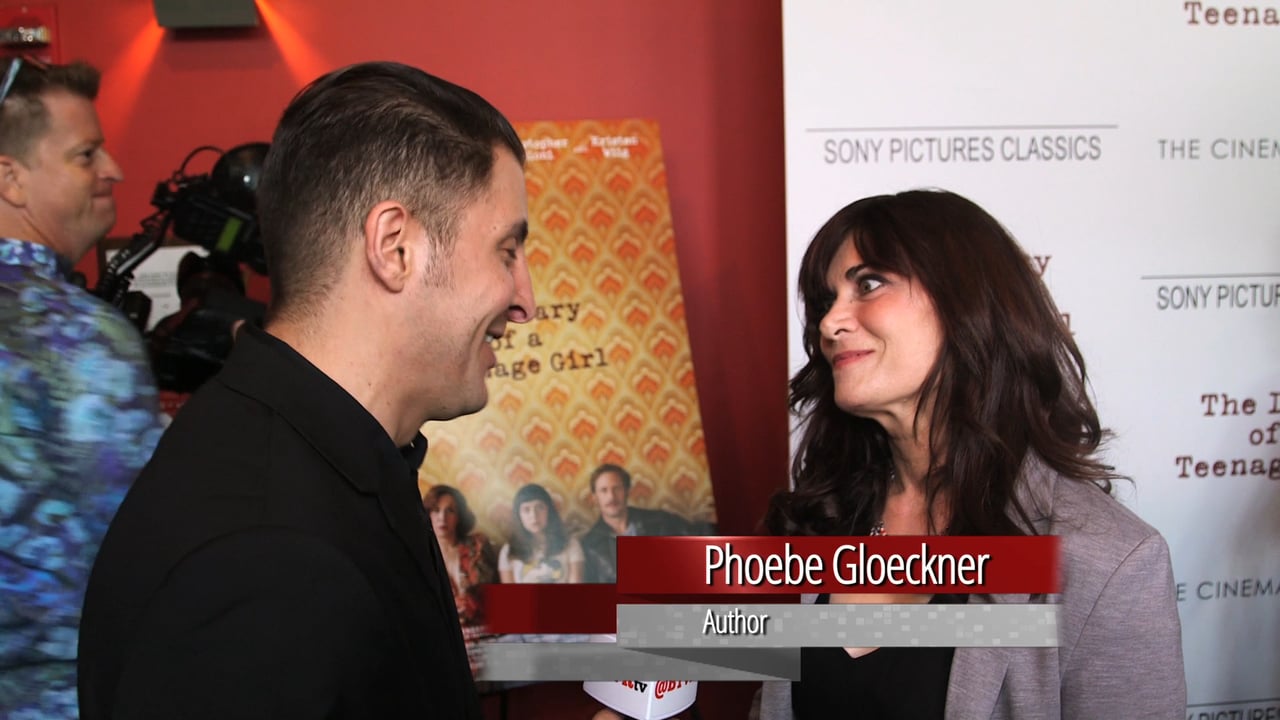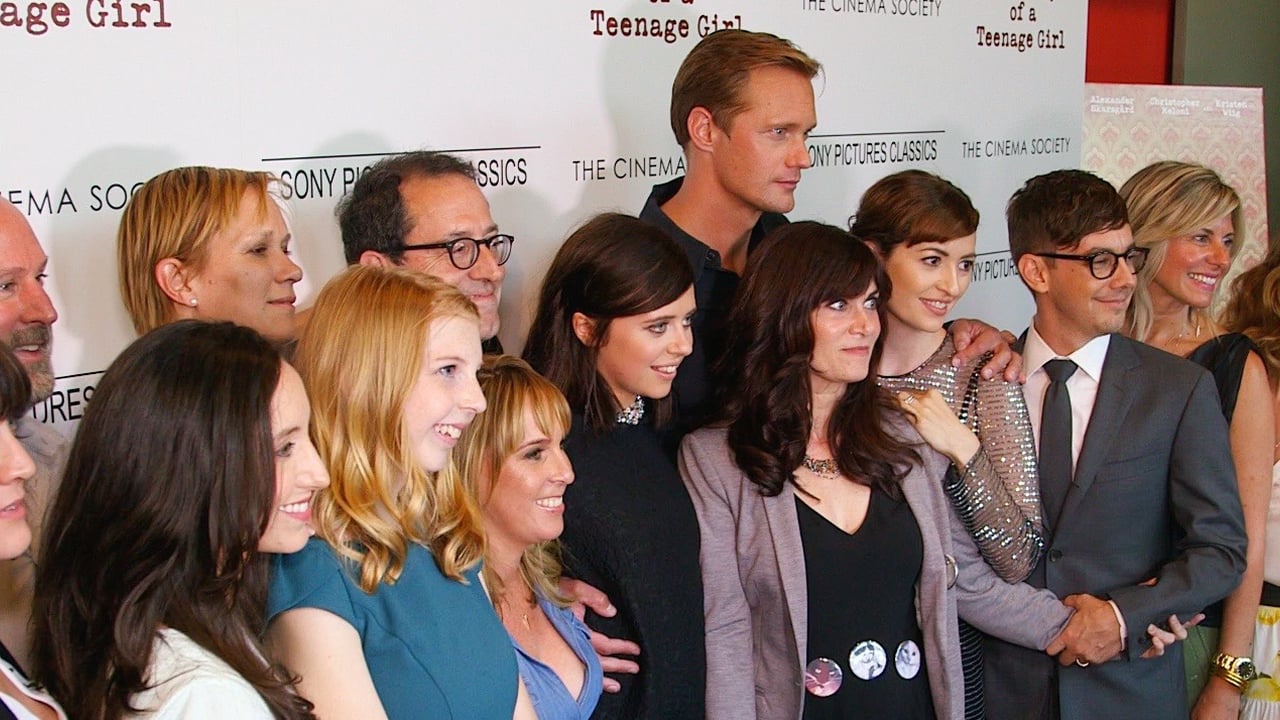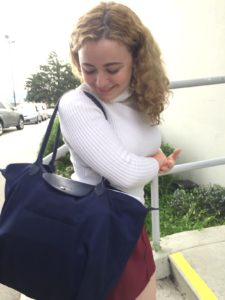
photo by Amelia Levin-Sheffield
The Diary of a Teenage Girl: An Account in Words and Pictures, a fusion of a graphic novel and part non-graphic, non-genred writing by Phoebe Gloeckner, was published in 2002. The play, Diary of a Teenage Girl directed by Marielle Heller, premiered in 2010 and the film, also directed by Heller and starring Bel Powley, Kristen Wiig and Alexander Skarsgard was released summer 2015. The graphic novel itself has been controversial. Cited as semiautobiographical, it combines booklike passages and graphic novel passages. Its blunt and visceral writing and drawings are lauded by some and criticized and gawked at by others. Some people see it as a brave, beautiful novel that gives a refreshingly realistic portrayal of adolescence, a lone voice among many who are prone to sugarcoating the trials of teenagehood. Others can’t see past the graphic images, that instead of shying away from the uncomfortable, seem to leap up and embrace it. I first became aware of the story through the movie. When it was released there was a quiet buzz going through the Lick community. Phoebe Gloeckner, the author, is a sort of alumni of Lick. As she explains in the interview, Lick is one of the many schools she attended throughout her high school years. So although not a graduated alum, Lick-Wilmerding does make a small appearance in her graphic novel and has been mentioned in a few of her interviews. I ended up watching the movie a few weeks after its release, in part because I liked the story, and in part because of the incredible cast. Bel Powley plays the lead, Minnie Goetz, the sort-of younger version of Gloeckner. Powley is a rising star, she has seven finished filming or upcoming projects spanning between 2016-2018 and she won the Chopard Trophy at Cannes in May 2016 for being a “Female Revelation.” Kristen Wiig, who takes on Minnie’s mother, is perhaps the most well known member of the cast, starring in everything from Bridesmaids to Despicable Me to The Martian. Alexander Skarsgard tackles the difficult role of Monroe, Minnie’s mother’s boyfriend. He’s a lesser known but equally brilliant actor. Skarsgard starred in Generation Kill, created by the team behind The Wire, one of my favorite television shows of all time and one my favorite movies, What Maisie Knew, alongside Julianne Moore and Steve Coogan. Aside from the cult popular True Blood, in which he starred for over five years, he tended to work on smaller projects until the release of The Legend of Tarzan earlier this year which co-starred Margot Robbie and Samuel L. Jackson. Like Powley, he has several projects in the works, four of which are slated for release in 2017. All in all, the acting in the film couldn’t be more stunning, and after laughing and crying my way through the film I ran straight for the graphic novel. I fell so in love with it that I reached out to Gloeckner to see if I could secure an interview.
Below is an excerpt from our conversation on September 10, 2016.
Amelia Levin-Sheffield: Your father was an illustrator and your mom a librarian–so becoming an illustrator and author is practically a birthright for you… Phoebe
Gloeckner: My dad was a really great artist and illustrator but he had a pretty bad drug problem and drinking problem and he ended up dying fairly young and selling all his work at bars for beer. He was incredibly talented. It was an odd birthright because, yes I took after him, but I also had a fear of becoming like him if I ever admitted to myself that I wanted to be an artist, so I would rarely say that, even though I was drawing all the time.
Levin-Sheffield: Do you feel like your family influence on your career was something you were aware of or trying to suppress?
Gloeckner: I was aware of it but it was a very fractured family, I saw my father maybe once a year. My grandmother was a doctor, and was actually pretty famous at the time and became the first woman vice president of the American Medical Association. I was always interested in science so instead of saying I was going to be an artist and running away and doing that, I went to school and graduate school and got a masters degree in biomedical communications but creatively that wasn’t my end goal.
Levin-Sheffield: In other interviews, you’ve stated that school wasn’t a very grounding experience for you, yet you attended what are arguably some of the very top schools in the San Francisco Bay Area. What disturbed or lead you to switch schools so often?
Gloeckner: I went to a Castilleja School for Girls on the peninsula for a little while, I was expelled from there. Then I went to Urban and was expelled from there. Then Lick, and I was expelled from here. Then I ended up at some school, I don’t know if it still exists, it’s called the Independent Learning School which was a school for a bunch of students who had gotten expelled from everywhere else. I tried going to public school but it was so overwhelming for me because there were so many students. I wasn’t stupid so I sometimes got scholarships so I could go to these others schools but it was kind of worthless because I didn’t go. I used to fall asleep on BART and wake up in Daly City, I’m sure it was on purpose, and then decide to walk home instead of going to school.
Levin-Sheffield: What caused you to view school in such an inconsequential way?
Gloeckner: I think my home life was so chaotic, there wasn’t really any grounding there so school seemed like an extension of that, it didn’t seem like a harbor it seemed like more noise. I was kind of lost I guess. I liked to walk a lot so I would sometimes go to noon services at church so I wouldn’t feel guilty about cutting school all the time, although I’m not religious.
Levin-Sheffield: Being an illustrator and author makes sense, but what lead you to become a teacher?
Gloeckner: Well if you’re familiar with the life of an artist, you know it’s difficult to make enough money to live so often artists do other things. I was in that position, I had been doing freelance illustration for most of my life and I would occasionally apply to community colleges to see if I could get something more regular. Time and time again they would say, “Comics don’t belong in a fine arts department” and I wouldn’t even be looked at. Then there was a four page story about me in the New York Times magazine with a big picture, someone had interviewed me a year previous and I thought it was a joke. Anyway, it was printed and then the University of Michigan called me up and asked me to apply for a job and I applied for it and they hired me. It wasn’t really planned, I think I was very flattered and didn’t really know what it entailed, to be a full-time professor, so I accepted it. Anyways it’s a different kind of life from living a freelance life.
Levin-Sheffield: How has being the mother of two teenage girls changed the way you think about coming-of-age, especially in our era in comparison to the wildly different time you grew up?
Gloeckner: I think it’s really different, however I think my teenagehood was, in a sense, an anomaly. In between getting kicked out of school, and having a single mother and lots of people in the house all the time. There are dysfunctional families like that in every generation and every century, lots of them. Generally if you have that recipe, something weird is going to happen to the kids, they’re vulnerable, and that kind of takes them out of the influence of time and place. Things will happen, according to when this takes place, what century, decade, but they are just kind of decoration because the bad things will happen anyways. I kind of had to learn to parent by mimicking my friends who I thought were good parents and asking a lot of questions, and trying to be the best parent I can. I admit that because I was kind of a wild dog as a teenager I was probably over protective at times.
Levin-Sheffield: You’ve referenced your work as being a sort of time capsule, if someone from the future were to read it what message would you want them to take away?
Gloeckner: I always hope that characters can be related to by people other than girls or women, it’s a coming of age story. I would hope people would read it as such, instead of just a story about a girl. I’m hoping they can look at it and see a somewhat deeper or fuller version of what it’s like to be a girl.
Levin-Sheffield: What was the idea behind the dedication, “This is for all the girls when they have grown”?
Gloeckner: When I hear that I can feel it and know what I mean. In writing the book I kind of had to abandon all self-consciousness. Because yes, it has sex and everything else but like I said, that’s not the point of the book. But it also couldn’t be lost and I didn’t want it to seem sweeter than it was. Anyway, in order to like that character (Minnie), I had to separate from her because I wasn’t fond of myself as a teenager. I had to somehow come to love the character and in order to do that I kind of had to think of her as any girl or every girl. I think that transference made me feel like, that’s who it’s for, that certainly part of me is anybody.
Levin-Sheffield: How do/did you feel when your work was banned for obscenity?
Gloeckner: It used to hurt my feeling and then I started feeling like, they aren’t reading the book or they’re just looking at pictures and not really thinking about it so maybe they can be excused or pilloried for stupidity, but ya, it kind of pisses me off.
Levin-Sheffield: Do you feel that the book is more valuable for teenagers or is it written for adults?
Gloeckner: I guess it depends on that person’s state of development. Sometimes people who’ve had very similar backgrounds as me write to me that they are very offended because now they’ve grown up and have kids and they wouldn’t let their kids read this, they aren’t going to tell their kids about their background, I don’t know, I think it depends on the individual.
Levin-Sheffield: Reviewers of Diary of a Teenage Girl often cite it as semi-autobiographical, do you agree with this assessment? And how do you see the book as autobiographical and how is it pure fiction?
Gloeckner: I’m always wobbly on this whole subject because honestly I don’t know what auto-biography is and I don’t know what pure fiction is. I think that we only have one point of view and that’s our own. As struggle as we may, to be a journalist or anything else you’re trying to put yourselves in someone else’s shoes, you’re trying to see things objectively but you never do. Every choice you make is a reflection of where you came from and what you’re thinking in that moment and what you’ve thought in the past. Even science fiction is expressing some dream or fear. I think that they can call it whatever they want to call it, the things that happened in the book are things that happened to the real me. However, in order to create the novel, certainly there’s a lot of artifice. I had diaries and diaries but narrative structure is very different than diaristic writing. There were a million characters on every page when I was writing about the school day and they never show up again. I’m not going to transcribe that. To make something more cohesive that everyone can follow you have to be a butcher as well as a writer and artist. Does that process take it from the realm of reality into pure fiction? Not really. What I was after was an emotional truth, something that would feel right.
Levin-Sheffield: How did you and Marielle Heller (the director of both the play and the film) become acquainted with each other ?
Gloeckner: She got the book for Christmas from her sister and Marielle was probably 25 but she was obsessed with the book and she wrote to me many times. She finally asked me if she could make a play. At that time several directors had asked me to make a movie and I just didn’t like what they were going to do. When she asked me I just drew a blank, how could it be a play? So I told her to knock herself out and she did. After it ran she wanted to make a movie and I could have been far more involved than I was but at the time I was involved in something else and I don’t think I could have returned to that again. I was involved peripherally as often as possible. I was on the set a lot, I traveled to San Francisco and came for weeks and was just watching these ghosts of my past play out scenes that were extremely familiar. I think she did a great job. And yes, it’s very different from the book in some ways but I think her experience was very different. It wasn’t as exposed as mine, she had a very intact family who adore her still and I think she almost wanted to protect Minnie from the bad things, so she didn’t quite let them happen in the movie. She escapes rape and any serious drug use, which is great. I think the relationship with the mother is much nicer in the movie. In the movie Minnie is almost the initiator of the relationship and honestly in the book she wasn’t. That bothered me because it changed the whole dynamic. Not to say that I was trying to villainize Monroe or anything, in the book, I wasn’t. But you know, Minnie didn’t suck Monroe’s finger in the bar scene.

Levin-Sheffield: You mentioned in an interview for Stamps (School of Art and Design at University of Michigan) that watching Marielle Heller’s play adaptation of Diary of a Teenage Girl was a very upsetting experience for you, why was it upsetting ? And why did you then decide to allow her to create the movie?
Gloeckner: It was upsetting because it was so jarring. It’s almost like things have been pulled out of your own head and made into a hologram which is a shocking thing. So why not let her make a movie?
Levin-Sheffield: Often movie adaptations can turn out to be very different, sometimes unrecognizable from the original book, how do you think your book and Heller’s movie are alike as well as different?
Gloeckner: A movie is such a different thing. First of all you have a musical soundtrack to it and music immediately pushes buttons. There’re all these musical devices that move you along and tell you when it’s time to feel this way or that way, it’s such a different thing that it’s hard to compare. I would never pick it apart and say this is different, that is different. Also, because of time constraints I think a few of the characters were more cardboard than as I real as I thought they could be. Like the Ricky boy was just a caricature and not even a very complete one. But of course, in a movie you just don’t really have the time and you have to focus on certain things to get the movie moving. A lot of the movie uses the cliches of our collective memory of the 70s but in reality it was very different. Most rooms in the 70s didn’t have crazy wallpaper, they looked exactly like this. Especially in San Francisco where there were so many Victorian buildings, they were exactly the same. Most people had hand-me-down furniture or old shit that looked like nothing and wasn’t a particular style. But in order to communicate, this is the 70s, it was really pushed. But the things that were really beautiful to me and that I really loved about that time weren’t in the movie because they weren’t in the zeitgeist of what we think about the 70s, but I think that’s probably a difference of experiences.
Levin-Sheffield: The book is more serious, darker than the movie, how do you reconcile those two differing accounts and do you feel like the movie cheated or sugar coated the original story? And why?
Gloeckner: At a certain point I can’t even really think about that because it’s like apples and oranges. Once you’re going to adapt a work that already exists, you’re either going to try and copy it faithfully or you’re going to have to interpret it through your own lens which is what most filmmakers would do if their hands aren’t being controlled by a studio. Marielle loved the book and she loved it for a reason which had to do with her own experience as a teenager. All people remember certain parts of books because there are certain things you’re going to relate to intensely, or not at all. I couldn’t interfere with what drove her to pursue the project in the first place. It was her first film and she really lived with the book for ten years. She obviously had something motivating her. I think of it as a related work, as a derivative work but that it’s an interpretation of another artist.
Levin-Sheffield: How involved were you with the movie making process?
Gloeckner: I got to give Alexander Skarsgard some advice. He would come up to me and ask, “What’s wrong with this guy? Why is he doing this? How did he end up like this? What is he doing now?” He was always asking me all these questions. He was great, he was very nice. Anyways, I hung out on set, taking pictures constantly, I don’t know if that helped or hindered anything. Both of my kids are in the movie, and worked on the movie. The older one worked on the set the whole time as a production assistant, it was actually her first big job after college. Marielle would send me scripts all the time but it was almost overwhelming because it was those words again. The dialogue sticks pretty well to the book and my brain was throwing the words back so I couldn’t really read them anymore. I was actually in the movie too. It was a bar scene and I’m sitting in the dark and Minnie storms out.

Levin-Sheffield: After seeing the film did you feel like certain actors portray your characters closest to what you’ve imagined and did certain actors re-imagine the character in a way you hadn’t thought of?
Gloeckner: I think Monroe is really well done and the mom too. Like I said, Ricky Wasserman was more caricature, he didn’t remind me of the character at all. I was just thinking about Minnie, if she’s like the other Minnie. The real Minnie was a little more sophisticated and a little more vigilant than the Minnie in the film, but entirely inexperienced. She knew a lot about the world of adults but was not very interactive with kids her age. The movie Minnie seemed a little more connected to the things she’s supposed to be connected to.
Levin-Sheffield: What are you working on now?
Gloeckner: I’ve been going to Ciudad Juárez Mexico right at the border of El Paso and Mexico, I’ve been going there for ten years now, three or four times a year. It all started when I was asked to go down there to do a short journalistic piece for amnesty international. They introduced me to all these parents of girls who’d been murdered and unlike a journalist I didn’t like the feeling of going in there, telling a story and coming out. I couldn’t. I hadn’t been able to scratch the surface. I got to know a family there and I’ve been immersing myself in that experience. It happened to coincide with a rise in violence at the border which now is subsiding somewhat. Actually a lot of dramatic things happened to me and people close to me. I had a family come live with me for a year in Michigan. Two members of the family had been murdered, they were activists and narcos had killed two of the family members quite violently and threatened the others. These two people came up to live with me and I got a law professor at the University of Michigan to represent them pro-bono in an asylum case. It took a year for them to get political asylum, but they did. Only half a percent of Mexican applications were granted that year. I think it was great that they came to the northern border rather than our southern border because it was just overwhelmed down there and they probably never would’ve gotten it. I’m not sure what to say about the project other than that it’s been this overwhelming experience that takes constant processing. I’ve done a lot of work for it and it’s not done yet and it’ll be done when it’s finished. That is probably why I was always a bad student because I’m not good with time. I have no concept of how long it takes me to do anything and I’m very willing to do something again if I don’t like it, to get rid of it and that’s not how you finish homework.






